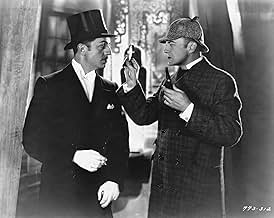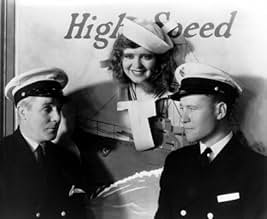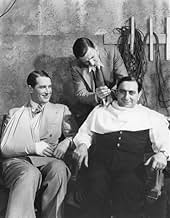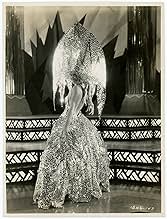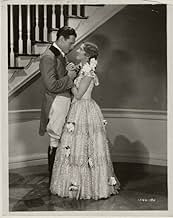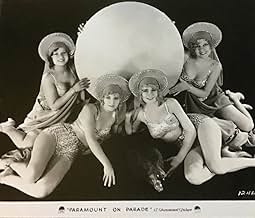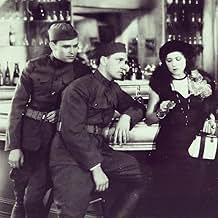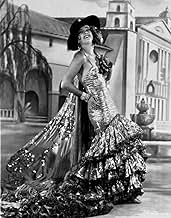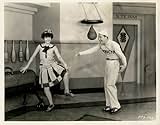CALIFICACIÓN DE IMDb
5.6/10
416
TU CALIFICACIÓN
Agrega una trama en tu idiomaA musical revue that has Paramount stars and contract-players doing unrelated short sketches and elaborately staged song-and-dance numbers like a duet on a giant cuckoo clock and Clara Bow s... Leer todoA musical revue that has Paramount stars and contract-players doing unrelated short sketches and elaborately staged song-and-dance numbers like a duet on a giant cuckoo clock and Clara Bow singing aboard a navy vessel.A musical revue that has Paramount stars and contract-players doing unrelated short sketches and elaborately staged song-and-dance numbers like a duet on a giant cuckoo clock and Clara Bow singing aboard a navy vessel.
- Premios
- 3 premios ganados en total
Charles 'Buddy' Rogers
- Buddy Rogers - Episode 'Love Time'
- (as Buddy Rogers)
Opiniones destacadas
A couple of years into the Talkie revolution, several studios put on feature-length revues to promote their brand, of which Paramount's effort seems to have been better than most, even though it has not worn particularly well since. (Also the print I watched was notably fuzzy and dim.)
Deservedly, it gives generous exposure to Maurice Chevalier, who had just rescued the studio's fortunes with his Ruritanian romance 'The Love Parade', just as the Wall Street crash was threatening to ruin Hollywood. In particular, his energetic closing act, 'Sweeping the Clouds Away', accompanied by an endless line of leggy beauties, was clearly meant as a cheer-up call for the Depression-hit masses.
As for the other performers, I can only say that they remind us of the transience of fame (at a range of nearly a century). Not one in ten of these names mean anything to us today. Jack Oakie seems to occupy second place, and although I have often enjoyed his work, I think he was personality rather than artistry. Interesting to catch a glimpse of the young Frederick March. Otherwise, Gary Cooper, Clara Bow and Fay Wray more-or-less complete the roll of memorable stars.
Deservedly, it gives generous exposure to Maurice Chevalier, who had just rescued the studio's fortunes with his Ruritanian romance 'The Love Parade', just as the Wall Street crash was threatening to ruin Hollywood. In particular, his energetic closing act, 'Sweeping the Clouds Away', accompanied by an endless line of leggy beauties, was clearly meant as a cheer-up call for the Depression-hit masses.
As for the other performers, I can only say that they remind us of the transience of fame (at a range of nearly a century). Not one in ten of these names mean anything to us today. Jack Oakie seems to occupy second place, and although I have often enjoyed his work, I think he was personality rather than artistry. Interesting to catch a glimpse of the young Frederick March. Otherwise, Gary Cooper, Clara Bow and Fay Wray more-or-less complete the roll of memorable stars.
"Paramount on Parade" (Paramount, 1930), with various directorial credit including Ernst Lubitsch, A. Edward Sutherland and Victor Schertzinger, among others, became Paramount's attempt in an all-star movie revue, following the earlier attempts of MGM's "The Hollywood Revue of 1929" and "The Show of Shows" for Warner Brothers, and while many claim this to be the best of the revues, I find it to be a disappointment mainly because the print that's been circulating on television over the last couple of decades, and later cable television, not being the entire movie. Even though I wasn't around when the 102 minute presentation of "Paramount on Parade" was released in theaters, the cuts are quite obvious, especially when French entertainer Maurice Chevalier gives Italian singer Nino Martini a special introduction, and later on in the revue, director Edmund Goulding preparing his cast of actors who are to appear in a Civil War setting musical skit, "Let Us Drink to the Girl of My Dreams," with Gary Cooper, Fay Wray, among others, which never comes. At present, "Paramount on Parade" runs 78 minutes, minus Technicolor segments. Whether the missing scenes are lost forever, or a complete copy is displayed somewhere in a dark vault gathering dust, is anyone's guess. However, at present, it appears that possible restoration of this movie is unlikely to occur.
The "Paramount on Parade" program is as follows, with the deleted scenes preceded with asterisks (*): * SHOWGIRLS ON PARADE (with Virginia Bruce); * PARAMOUNT ON PARADE (chorus); "We're the Masters of Ceremonies" (sung by Jack Oakie, Richard "Skeets" Gallagher and Leon Errol); "Any Time's the Time to Fall in Love" (sung by Buddy Rogers and Lillian Roth); MURDER WILL OUT (a comedy sketch with William Powell as Philo Vance; Clive Brook as Sherlock Holmes; Warner Oland as Fu Manchu, with Eugene Palette and Jack Oakie; THE ORIGIN OF THE APACHE (with Maurice Chevalier and Evelyn Brent); IN A HOSPITAL (comedy sketch with Leon Errol, Jean Arthur, Phillips Holmes and David Newell); "I'm in Training for You" (sung by Zelma O'Neal and Jack Oakie); * THE TOREADOR (with Harry Green singing "I'm Isador the Toreador" from Bizet's CARMEN, with Kay Francis); "My Marine" (sung by Ruth Chatterton, with Fredric March, Stanley Smith and Stuart Erwin as Marines); "All I Want is Just One Girl" (sung by Chevalier); MITZI GREEN HERSELF (with Mitzi Green reprising "All I Want Is Just One Girl" and doing imitations of Chevalier and Charles Mack of the comedy team of Moran and Mack, The Two Black Crows); "What Did Cleopatra Say?" (sung by Helen Kane); *THE GALLOWS SONG (sung by Dennis King); "Dancing to Save My Sole" (sung and danced by Nancy Carroll and Al Norman, the eccentric rubber-legs dancer); * DREAM GIRL, "Let Us Drink to the Girl of My Dreams" (with Richard Arlen, Jean Arthur, Gary Cooper, Mary Brian, Virginia Bruce, Fay Wray, and others); "I'm True to the Navy Now" (sung by Clara Bow and sailors); FOLLOWING YOUR IMPULSE: (Introduced by George Bancroft in a comedy sketch about social manners showing how people at a function normally act, then presenting them on how they really feel. Kay Francis partakes in this skit); and the finale, "Sweeping the Clouds Away" (sung by Maurice Chevalier).
As with the previous Hollywood revues, portions of the film succeed musically and comically, while others don't. Highlights include Zelma O'Neal's energetic singing and opposite Jack Oakie in the gymnasium; Nancy Carroll's dance number on top of a giant shoe; Maurice Chevalier's finale; and of course Clara Bow, who brings this revue to life as the sole female vocalist amongst a group of sailors. Her singing voice does record well, but her career in talkies came to an end by 1933. The lesser moments are the comedy skits, including Leon Errol in the hospital bed with his good-for-nothing sons ignoring his requests and telling their dad to "Shut up"; Mitzi Green's dated impersonations of Moran and Mack; and the singing of "My Marine" by Ruth Chatterton, who performs better as dramatic actress than as a singer, making this eight minute segment seems longer than it is. Helen Kane's "Boop, Boopa Doop" number in the classroom starts off well, but grows tiresome only after a few minutes.
American Movie Classics formerly presented the edited version of "Paramount on Parade" back in 1988-89, and since then, is hardly shown at all these days. However, if this revue should ever resurrect again, whether on video or on Turner Classic Movies, let's hope for a restored complete version. Maybe the 102 minute edition might not make much of a difference entertainment wise, but it certainly will be a rare treat indeed. As it now stands ... (***)
The "Paramount on Parade" program is as follows, with the deleted scenes preceded with asterisks (*): * SHOWGIRLS ON PARADE (with Virginia Bruce); * PARAMOUNT ON PARADE (chorus); "We're the Masters of Ceremonies" (sung by Jack Oakie, Richard "Skeets" Gallagher and Leon Errol); "Any Time's the Time to Fall in Love" (sung by Buddy Rogers and Lillian Roth); MURDER WILL OUT (a comedy sketch with William Powell as Philo Vance; Clive Brook as Sherlock Holmes; Warner Oland as Fu Manchu, with Eugene Palette and Jack Oakie; THE ORIGIN OF THE APACHE (with Maurice Chevalier and Evelyn Brent); IN A HOSPITAL (comedy sketch with Leon Errol, Jean Arthur, Phillips Holmes and David Newell); "I'm in Training for You" (sung by Zelma O'Neal and Jack Oakie); * THE TOREADOR (with Harry Green singing "I'm Isador the Toreador" from Bizet's CARMEN, with Kay Francis); "My Marine" (sung by Ruth Chatterton, with Fredric March, Stanley Smith and Stuart Erwin as Marines); "All I Want is Just One Girl" (sung by Chevalier); MITZI GREEN HERSELF (with Mitzi Green reprising "All I Want Is Just One Girl" and doing imitations of Chevalier and Charles Mack of the comedy team of Moran and Mack, The Two Black Crows); "What Did Cleopatra Say?" (sung by Helen Kane); *THE GALLOWS SONG (sung by Dennis King); "Dancing to Save My Sole" (sung and danced by Nancy Carroll and Al Norman, the eccentric rubber-legs dancer); * DREAM GIRL, "Let Us Drink to the Girl of My Dreams" (with Richard Arlen, Jean Arthur, Gary Cooper, Mary Brian, Virginia Bruce, Fay Wray, and others); "I'm True to the Navy Now" (sung by Clara Bow and sailors); FOLLOWING YOUR IMPULSE: (Introduced by George Bancroft in a comedy sketch about social manners showing how people at a function normally act, then presenting them on how they really feel. Kay Francis partakes in this skit); and the finale, "Sweeping the Clouds Away" (sung by Maurice Chevalier).
As with the previous Hollywood revues, portions of the film succeed musically and comically, while others don't. Highlights include Zelma O'Neal's energetic singing and opposite Jack Oakie in the gymnasium; Nancy Carroll's dance number on top of a giant shoe; Maurice Chevalier's finale; and of course Clara Bow, who brings this revue to life as the sole female vocalist amongst a group of sailors. Her singing voice does record well, but her career in talkies came to an end by 1933. The lesser moments are the comedy skits, including Leon Errol in the hospital bed with his good-for-nothing sons ignoring his requests and telling their dad to "Shut up"; Mitzi Green's dated impersonations of Moran and Mack; and the singing of "My Marine" by Ruth Chatterton, who performs better as dramatic actress than as a singer, making this eight minute segment seems longer than it is. Helen Kane's "Boop, Boopa Doop" number in the classroom starts off well, but grows tiresome only after a few minutes.
American Movie Classics formerly presented the edited version of "Paramount on Parade" back in 1988-89, and since then, is hardly shown at all these days. However, if this revue should ever resurrect again, whether on video or on Turner Classic Movies, let's hope for a restored complete version. Maybe the 102 minute edition might not make much of a difference entertainment wise, but it certainly will be a rare treat indeed. As it now stands ... (***)
You get to see dozens of early talkie stars in this hodgepodge. The short "drama" sequences and most of the "comedy" sequences are awful, but the singing and dancing routines are tops. My favorites are the "I'm in Training for You" routine (Jack Oakie and Zelma O'Neal), the "Dancing to Save Your Soul" routine (Nancy Carroll and an uncredited Al Norman - the great deadpan rubberlegs dancer), Maurice Chevalier singing "All I Want is Just One" and "Sweeping the Clouds Away" and little Mitzi Green imitating Chevalier.
Well much of this Paramount landmark talkie is missing but what remains is entertaining and it's fun to see the old stars in their primes. Copying MGM's Hollywood Revue of 1929, which earned a best picture Oscar nomination and was a smash, Paramount on Parade has a lot of talent but the film seems cheesy compared to the MGM revue. However, this served as the talkie debut of a lot of stars on the Paramount lot. Among the major names: Clara Bow, Maurice Chevalier, Kay Francis, William Powell, Jean Arthur, Gary Cooper, Nancy Carroll, Ruth Chatterton, Fay Wray, Fredric March, Lillian Roth, Buddy Rogers. And also Jack Oakie, Mitzi Green, Leon Errol, Harry Green, Stu Erwin, Cecil Cunningham, Warner Oland, Eugene Palette, Clive Brook, Skeets Gallagher, Al Norman, Mary Brian, Zelma O'Neal, Helen Kane, George Bancroft, Mischa Auer, etc.
Most of the skits are duds but the musical numbers of funny and snappy, especially Chevalier in "Sweeping Away the Clouds," Helen Kane in a "Poop-a-Doop" classroom number, 8-year-old Mitzi Green doing impressions, Clara Bow in her splashy Navy number, Nancy Carroll quite good in her "shoe" dance, and Jack Oakie and Zelma O'Neal in their gym number.
Where the MGM film had unity via a master of ceremony (Jack Benny) this film seems like a bunch of "shorts" strung together but maybe that's because of the missing material.
Most at ease among the many big stars are Clara Bow and Maurice Chevalier who are energetic, snappy, and not afraid of the mike..... Worth a look.
Most of the skits are duds but the musical numbers of funny and snappy, especially Chevalier in "Sweeping Away the Clouds," Helen Kane in a "Poop-a-Doop" classroom number, 8-year-old Mitzi Green doing impressions, Clara Bow in her splashy Navy number, Nancy Carroll quite good in her "shoe" dance, and Jack Oakie and Zelma O'Neal in their gym number.
Where the MGM film had unity via a master of ceremony (Jack Benny) this film seems like a bunch of "shorts" strung together but maybe that's because of the missing material.
Most at ease among the many big stars are Clara Bow and Maurice Chevalier who are energetic, snappy, and not afraid of the mike..... Worth a look.
"Paramount On Parade" is both a musical revue and a collection of skits by Hollywood stars who can sing and some who cannot. The entertainment value is uneven as some of their stints in front of the camera range from pretty good to mediocre, from Maurice Chevalier to George Bancroft, whose forte was gangster roles. The movie was an excuse for Paramount to showcase as much of their stable of stars as they could assemble, and there were quite a lot of them. I understand that there were a spate of star revue-type pictures produced around the start of the sound era, and this was another one in that mold.
The main reason to see this picture in 2010, I found, was as a museum piece, watching old stars that I had only heard of. Hadn't seen much of Mitzi Green to speak of, ditto Skeets Gallagher, and had never seen Harry Green before. From that standpoint it was fascinating, but maybe not for moviegoers older than me. There was a good skit with four old-time movie sleuths, Warner Oland, William Powell, Clive Brook and Eugene Palette (who was more of a movie dim-witted cop).
On the IMDb site it is clocked at 77 minutes but at Capitolfest in Rome,N.Y. (8/10), a 102 minute 35mm print restored by the UCLA film department was shown which made it extra special.
The main reason to see this picture in 2010, I found, was as a museum piece, watching old stars that I had only heard of. Hadn't seen much of Mitzi Green to speak of, ditto Skeets Gallagher, and had never seen Harry Green before. From that standpoint it was fascinating, but maybe not for moviegoers older than me. There was a good skit with four old-time movie sleuths, Warner Oland, William Powell, Clive Brook and Eugene Palette (who was more of a movie dim-witted cop).
On the IMDb site it is clocked at 77 minutes but at Capitolfest in Rome,N.Y. (8/10), a 102 minute 35mm print restored by the UCLA film department was shown which made it extra special.
¿Sabías que…?
- TriviaOf the original 20 individual sequences, seven of them were filmed in 2-strip Technicolor: the opening sequence: 'Showgirls on Parade', Nino Martini's 'Come Back to Sorrento,' Harry Green's 'Isadore the Toreador' with Kay Francis, Dennis King's 'Nitchavo,' 'Girl of My Dreams', with Richard Arlen, Jean Arthur, Mary Brian, Virginia Bruce, Gary Cooper, James Hall, Phillips Holmes, David Newell, Joan Peers, and Fay Wray, of which only the B&W introduction survives, and the 'Rainbow Revels' finale featuring Maurice Chevalier singing 'Sweeping the Clouds Away', which also survives in B&W. The total Technicolor footage was 2517 feet (768 m), or about 28 minutes.
- ErroresThe re-release opening credits credit producer Jesse L. Lasky as "Jessie" L. Lasky.
- Citas
Jack Oakie: It's a mystery play written especially for me!
- Versiones alternativasVersion for distribution of the original film in Romania, titled Parada Paramount (1930) included additional sketches by Romanian actors Ion Ian-Covescu and Pola Iliescu
- ConexionesAlternate-language version of Parada Paramount (1930)
- Bandas sonorasAll I Want Is Just One Girl
Music by Richard A. Whiting
Lyrics by Leo Robin
Sung by Maurice Chevalier
Sung also by Mitzi Green
Selecciones populares
Inicia sesión para calificar y agrega a la lista de videos para obtener recomendaciones personalizadas
- How long is Paramount on Parade?Con tecnología de Alexa
Detalles
- Fecha de lanzamiento
- País de origen
- Idiomas
- También se conoce como
- Paramount on Parade
- Locaciones de filmación
- Productora
- Ver más créditos de la compañía en IMDbPro
- Tiempo de ejecución
- 1h 42min(102 min)
- Color
- Relación de aspecto
- 1.20 : 1
Contribuir a esta página
Sugiere una edición o agrega el contenido que falta

